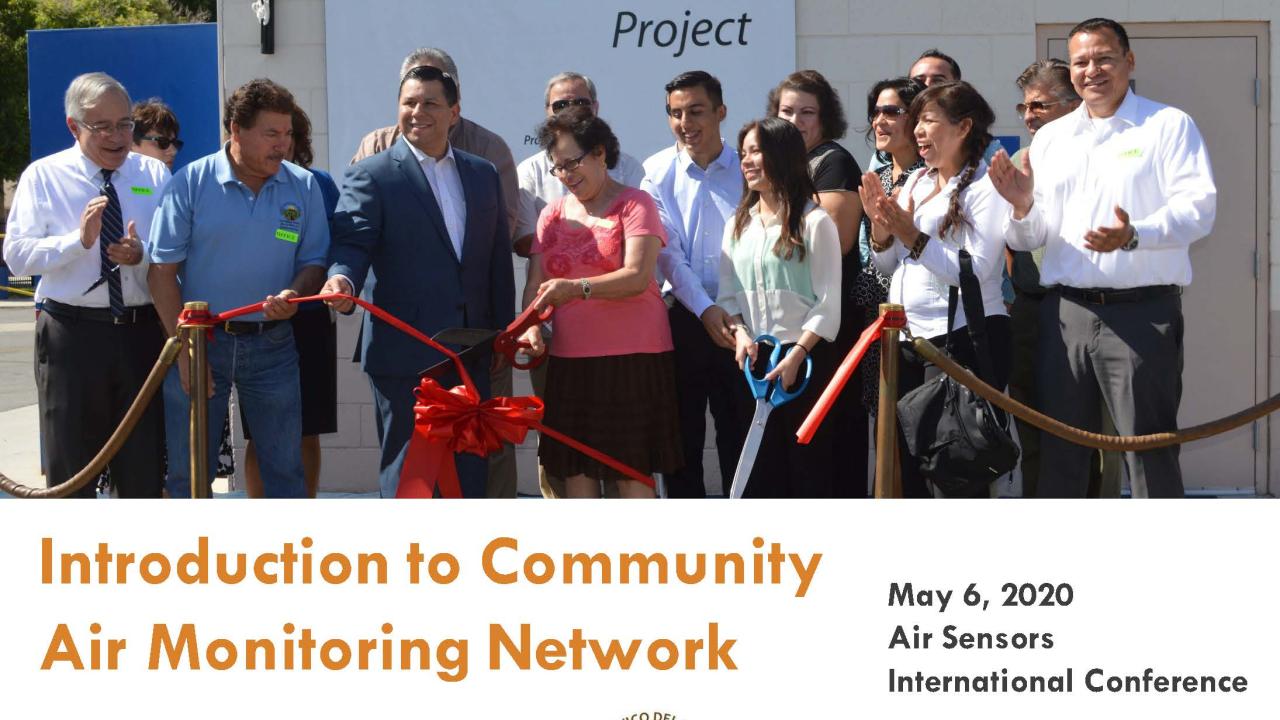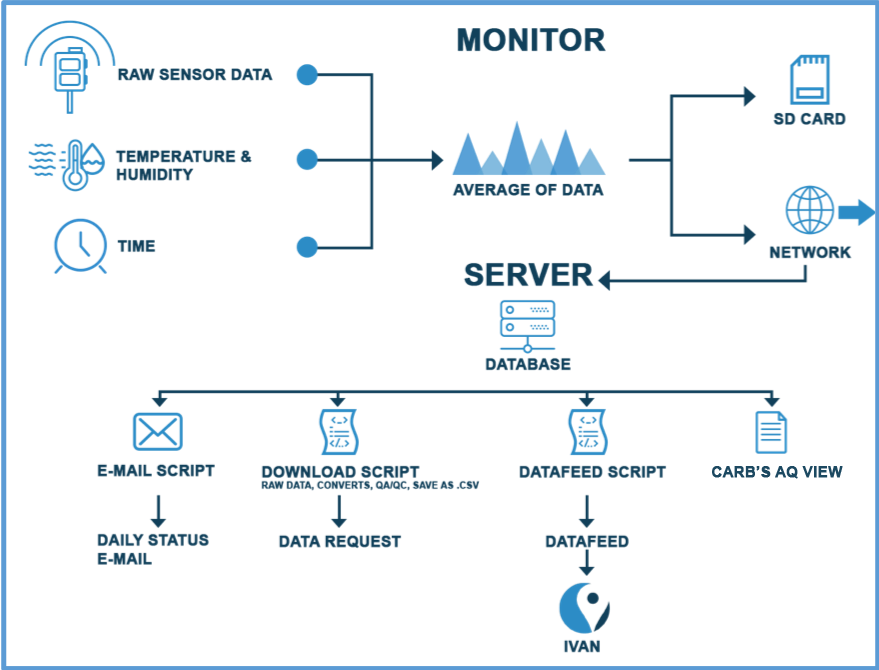
Event Date
Instructors: David Chang, Catalina Garzon & Paul English, California Department of Public Health, Christian Torres, Comite Civico del Valle
Description: Tracking California will provide an overview of the process involved in developing a community air monitoring network, based on our experience partnering with Comite Civico del Valle to establish a monitoring network that provides real-time information on particulate matter levels in Imperial County. The presentation will highlight a parallel process to the 14 elements laid out by the California Air Resources Board’s (CARB) community air monitoring plan and additional considerations from our "Guidebook for Developing a Community Air Monitoring Network." The presentation will incorporate materials from several community air monitoring workshops that Tracking CA has developed and delivered with community partners in Southern, Central and Northern California over the past year with funds from CARB. The topics covered in this workshop include: deciding whether a community air monitoring project is right for your community, setting goals for your community air monitoring project, putting together a team with the skills needed to carry out your project, establishing a Community Steering Committee to guide your project, selecting a monitor and ensuring data quality, and engaging community residents in key decisions like selecting locations for the monitors and sustaining the air monitoring project over time.
Full Training
Your Additional Questions Answered!
How do community orgs get educated on this topic?
Christian: For maintenance of the community monitors there is a record of all work completed and filed by staff. Records keeping was updated from paper-pen to spreadsheets/logs using ODK (Open Data Kit) and the form entries it allows for use. Logs record GPS coordinates, time stamps, and summary of work completed. There is draft documentation on QA which also documents and creates new files during the process to guarantee original data is never manipulated. There are 3 original data sets which are untouched; 1 – SD card on monitor, 2 – Comite Civico’s server, and 3 – Tracking California’s server. The graphic below explains how the data flows through the system as well.
As the partner community organization, we built this capacity during the transfer of the network from the PI to ourselves for long-term maintenance and operations. We have taken opportunities to collaborate with researchers, academia, and state agencies to build and acquire the knowledge needed for the network over time.

Have you developed a QAPP? What advice could you give to community groups for developing their own QAPP?
Christian: There is no official QAPP as it was not planned or required for this community science project. There is draft documentation which has been written by the QA/QC team in accordance with the work developed by the designer of the network. In developing this further we are following guidance offered by California Air Resources Board (CARB) Monitoring Lab Division (MLD). One piece of advice to give other groups who take a similar approach to their networks is to develop a plan which is they are capable of carrying out by having proper resources and capacity, either internal or with partners in the project.
Helpful resources for development of a QAPP:
The Volunteer Monitor’s Guide to Quality Assurance Project Plans
Quality Assurance Handbook and Guidance Documents for Citizen Science Projects
How do you conduct outreach to community members who might not have internet access? How do you anticipate changing your outreach as social distancing continues?
Christian: We have always used various methods of outreach to members of the community. As we have a host of programs that serve public health and educational campaigns, we include printed material and make ourselves available to the community for conversations when asked. We also conduct many in-person presentations at local events pre-COVID-19 and now use our telephone hotline to assist community members. Many programs also have printed materials which are now being distributed at public service areas which we are assisting at during the pandemic, such as at food distribution centers and local school lunch distributions where we assist with distribution and can provide materials for local community resources. Our outreach has thus migrated to telephone, social media, and local assistance distributions.
Any advice or considerations for using personal monitors to increase citizen awareness. Any recommendations on personal monitors?
David. In the past, I’ve had the opportunity to use the AirBeam (version 1) for increasing citizen science and awareness. It is fairly easy to use but there may be some limitations depending on what you are trying to do; I’ve used it to for increasing awareness around heavily trafficked areas but am unfamiliar with how this monitor would be used to set up a network approach. If you’d like to reach out about how I used this monitor in education programs, please email me at david.chang@trackingclaifornia.org. Generally speaking, I would recommend looking at AQ-SPEC as a place to start for which monitors to use.
Rich Callan: Here is some guidance from EPA on quality assurance for Citizen Science projects: https://www.epa.gov/citizen-science/quality-assurance-handbook-and-guidance-documents-citizen-science-projects
Ethan McMahon: EPA has a Quality Assurance for Citizen Science Projects page: https://www.epa.gov/citizen-science/quality-assurance-citizen-science-projects and a Quality Assurance Handbook and Guidance Documents for Citizen Science Projects at: https://www.epa.gov/citizen-science/quality-assurance-handbook-and-guidance-documents-citizen-science-projects
When discussing the process of developing an air-monitoring network, it implied to select only one monitor. Have networks been considered that would include multiple types of monitors, such as stationary, mobile and personal?
Tracking CA Yes, Paul mentioned the case of West Oakland Environmental Indicators Project: there were stationary monitors that were deployed at the same time as a mobile monitoring system led by Google/Aclima.
Ease of maintenance is essential for every long-term project! Our poll respondents overlooked this Key point.
Tracking CA. Yes, ease of maintenance should be considered for every long-term project. We don’t disagree however we think it is lower in the priority list when deciding which monitor makes the most sense for your project. A monitor may be very easy to maintain but that does not necessarily mean it is the right monitor for the pollutant you may be trying to measure, what the community needs, and what your project team has capacity to do.
How do you protect from vandalism?
Christian: Because monitors are outside of public access (i.e. installed on rooftops or sides of buildings) they are not prone to vandalism. Only one case has been documented in our network, as discussed by Dr. English this might be because Imperial is a rural area. A measure that can be recommended is to site monitors in areas that require special access (i.e. site host permission, special keys, etc.).
Colocation monitors - how long should be employed for? Do you think 1 year covering all seasons is sufficient for community monitoring purposes?
Tracking CA. If possible, permanently install a community monitor at the colocation site so your conversion equation can be kept up to date. Particle composition in an area may change over time, so the conversion equation should be updated regularly to account for this. If ongoing colocation isn’t feasible, the colocation should last for a year if possible so that seasonal differences can be accounted for. If this is not possible, then the community air monitor should be collocated for one month during
Can you share a model or template for a formal agreement with a monitor host?
Christian: Templates of monitor host outreach materials and site host agreement can be found in Appendix F of the Guidebook for Developing A Community Air Monitoring Network.
Could you provide the address that we can check the on-line data from Imperial Project.
Paul English: Here is the IVAN air website: https://ivan-imperial.org/index.php?r=monitoring
Is there any African Americans involved there? If so what areas?
Christian: The steering committee varied in its make-up, with Latino and Caucasian members making up the committee. The project team at our organization is of Latino descent with many of us first generation American.
Why can’t real-time data be used to investigate polluters?
Tracking CA. For any monitor or instrument to be used for regulatory activities, it must meet either the federal reference method (FRM) or federal equivalent method (FEM) requirements. These rigrous requirements have not yet been met by any low-cost sensor (to our knowledge). Community Air Monitoring Networks use low-cost sensors that are not approved by regulatory agencies for use in regulatory actions and thus their data can’t be used to prove violations. However, they can still provide supplemental data useful to communities, academic researchers, agencies, and others. See Chapter 9 in the Guidebook for Developing a Community Air Monitoring Network.
What's the flag program all about?
Christian: The Air Quality School Flag Program is a voluntary program in which we work with schools to educate about local air quality and how to mitigate exposure to bad air quality days. Schools (staff and student body) are educated about the effects of exposure to bad air quality and are taught to use the IVAN Air network to reduce exposure. Schools volunteer to raise a flag corresponding to the level of the Community Air-quality Level at start of school day, lunch time, and end of the school day. Schools are also given recommendations on ways to reduce exposure to bad air quality days by the Flag Program staff. More information can be found here.
When selecting monitor locations - is there a need for a random distribution sample or do you let the community lead these and worry less about a random sample?
Christian: The general strategy used for monitor locations in the Imperial Project was 20 by community concerns and 20 by analysis and coverage. More details of the locations selected can be found here.
This ultimately depends on a number of different factors including how many monitors you have available, what are the project team and community steering committee’s priority areas are, and additional information you have that might impact monitoring.
How long did it take to develop, finalize and implement the Imperial Valley Monitoring Plan and Network?
Tracking California. The Imperial County Community Air Monitoring Network of 40 real-time particulate matter monitors was initially established through a 5-year Research to Action grant from the National Institutes of Environmental Health Sciences (NIEHS) managed by Tracking California from 2013-2018. The expansion of the network continues through several ongoing community air monitoring projects funded by an AB 617 Community Grant from the California Air Resources Board managed by Comite Civico del Valle in Imperial County and Eastern Coachella Valley CA.
How do you identify Hazardous Air Toxics, if any are of concern in the imperial area?
Christian: We were able to leverage our community network to partner with our local air district into the Community Air Protection Program. Under the Program we were able to provide guidance to a steering committee which has identified monitoring hazardous air toxics at areas throughout Imperial. The community network itself does not identify these toxics but was able to build capacity to leverage for this extended monitoring which will occur with regulatory instruments.
How did you engage local businesses and industry responsible for community impacts and more importantly motivate them to take action and reduce their emissions?
Christian: Local businesses are now aware that there is a tool which is aiding members of the community in understanding the impacts to their air quality. Our current work in development of emission reductions strategies with the air district and state of California has been informed by what many in the community wish to see remediated in regard to business practices. Many in industry are not always complacent to comments and what these strategies entail but are open to providing input into what is feasible within the time periods we estimate for emissions reductions.
What approaches or tools have been useful for assessing community access of the air quality data? What about how they are interpreting this data and potentially taking action to protect their health?
Christian: We are working on tools to track the metrics of our website. We also track the feedback from partners who use the network to develop culturally appropriate messaging while maintaining the simplicity of our Community Air-quality Levels data displays. These displays give health recommendations which give a recommendation depending on the level.
Tracking California. Community members can access real-time data collected by the monitors in the network on the IVAN AIR Imperial website (https://ivan-imperial.org/). They can also sign up for text alerts to receive alerts when air quality is bad for specific air monitors near where they live, work or go to school. Community health workers at CCV conduct ongoing outreach and education to community members about ways to access the data, what the various colors and levels in the air quality index used to display this data mean, and actions that people can take based on this data to reduce their exposure to air pollution. We have also held community meetings and events to raise awareness about the data, how it can be accessed and used to better protect health, and to share the results of analyses based on the data with community members to identify broader air quality trends.
Any improvement in air quality (Lowering of pm concentrations) that can be related to publication of data and distribution to key decision makers?
Christian: Efforts are being made by to reduce emissions. Impact of our network and project can be seen in the structure that California developed for the Community Air Protection Program from Assembly Bill 617. The model the program uses aka 14 Elements for Community Air Monitoring are borrowed from the process and implementation of our project. California has designated 13 communities throughout the state for both/either Community Air Monitoring and/or Emissions Reductions, with others to come each year.
What is guidance on monitor install height? Is some variation OK?
Christian: For monitor installations we try to follow the guidelines set up by the California Air Resources Board and EPA. The siting criteria for EPA can be found here and the CARB siting criteria can be found here. This is explained in Chapter 14 of the Guidebook (page 84). There have been some scenarios where we have used best practices as the siting criteria became impossible to adhere to because of logistics in particular sites.
Have additional questions? Contact the presenters:
Paul English, Program Director and Principal Investigator, Tracking California
Catalina Garzón-Galvis, Senior Health Educator, Tracking California
David Chang, Project Coordinator, Tracking California
Christian Torres, Special Projects Manager, Comite Civico del Valle
Participants can also direct questions to info@trackingcalifornia.org OR contact@ccvhealth.org
